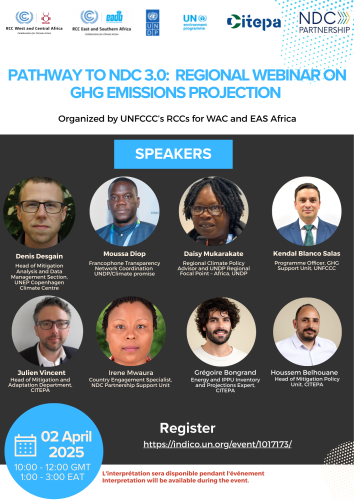Background
As countries prepare for their NDCs 3.0 submissions due this year,2025, the development of greenhouse gas (GHG) emissions projections has become increasingly critical for setting ambitious and implementable climate targets. GHG emissions projections are essential tools for policymakers to establish evidence-based GHG reduction targets, track progress toward these targets, and assess the expected impacts of mitigation measures.These projections serve as crucial components in NDC development, helping countries understand their emission trajectories under different scenarios: Business as Usual (BAU) / Without Measures (WOM), With Measures (WEM), and With Additional Measures (WAM).
Many Sub-Saharan African countries face challenges in developing comprehensive GHG projections due to limited data availability, technical capacity constraints, and access to appropriate modeling tools. This challenge is particularly significant as countries prepare their NDC 3.0 submissions, which require increased ambition and more detailed technical analysis to support their targets. The development of GHG emissions projections for NDC 3.0 must align with the requirements outlined in Decision 4/CMA.1, which specifies the need for clear quantifiable information on reference points, including base years and reference periods. Countries are required to provide detailed quantifiable information on reference indicators, their values in base years, and target years, along with clear numerical targets expressed as percentage or amount of reduction.
This information must be supported by robust data sources and methodologies. Furthermore, countries need to specify their implementation timeframes and whether they are adopting single-year or multi-year targets. These requirements make it essential for countries to develop comprehensive GHG emissions projections that can effectively demonstrate their baseline scenarios and the impact of their mitigation measures, while ensuring transparency and clarity in their NDC communications.
To support countries in this process, various tools exist to develop GHG emissions projections, such as GACMO, LEAP, and Mitigation-Inventory Tool for Integrated Climate Action (MITICA) - the latter being a free tool developed by the UNFCCC secretariat to help developing countries create GHG emissions scenarios, evaluate mitigation actions, and track NDC progress based on their national GHG inventories. It is against this background that the UNFCCC Regional Collaboration Centres (WACA and EASA) in collaboration with the Centre Interprofessionnel Technique d'Études de la Pollution Atmosphérique (CITEPA), United Nations Development Programme (UNDP), United Nations Environment Programme (UNEP) and the NDC Partnership are organizing a webinar aimed at supporting Sub-Saharan African countries in developing robust GHG emissions projections for their NDCs 3.0 submissions.
Objectives
The webinar aims to:
1. Provide guidance on developing BAU, WEM, and WAM scenarios for NDC 3.0, including methodological approaches and best practices for GHG emissions projections.
2. Enhance technical capacity in using tools and methodologies for GHG emissions projections, with particular focus on country-specific circumstances and data availability.
3. Facilitate knowledge exchange on successful approaches to GHG projections development, including data collection, scenario building, and stakeholder engagement.
4. Guide participants on integrating GHG projections into their NDC 3.0 submissions and using projections to inform target setting and policy planning. Participants The webinar will bring together National Focal Points, NDC Coordinators, Transparency, climate, sectoral and planning experts including specialists working on climate and NDC planning strategies of 45 countries from sub-Saharan African region alongside experts from the region including key partners both within and outside the wide UN support on NDC 3.0 .
LINK:
Kindly register here: https://indico.un.org/event/1017173/
